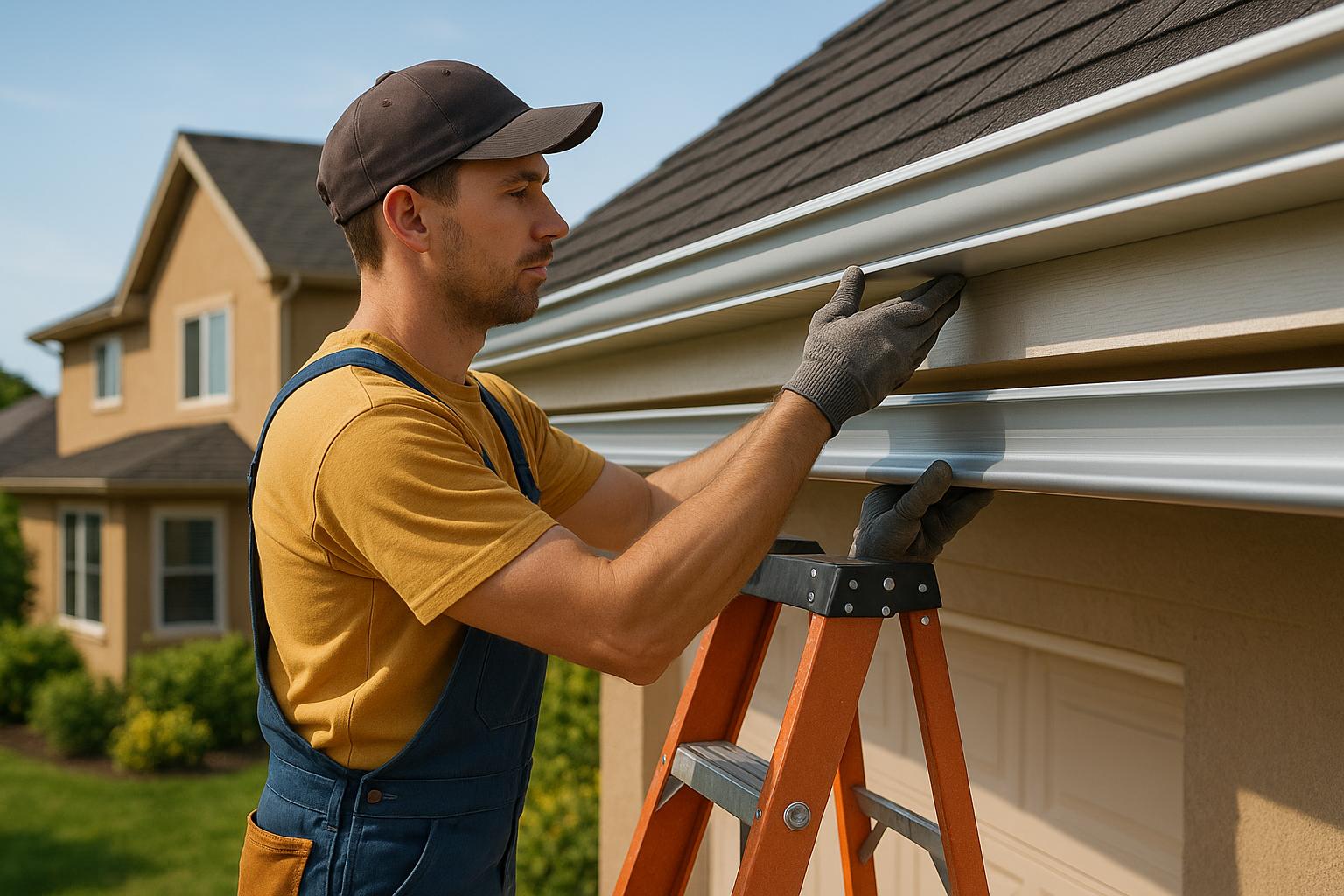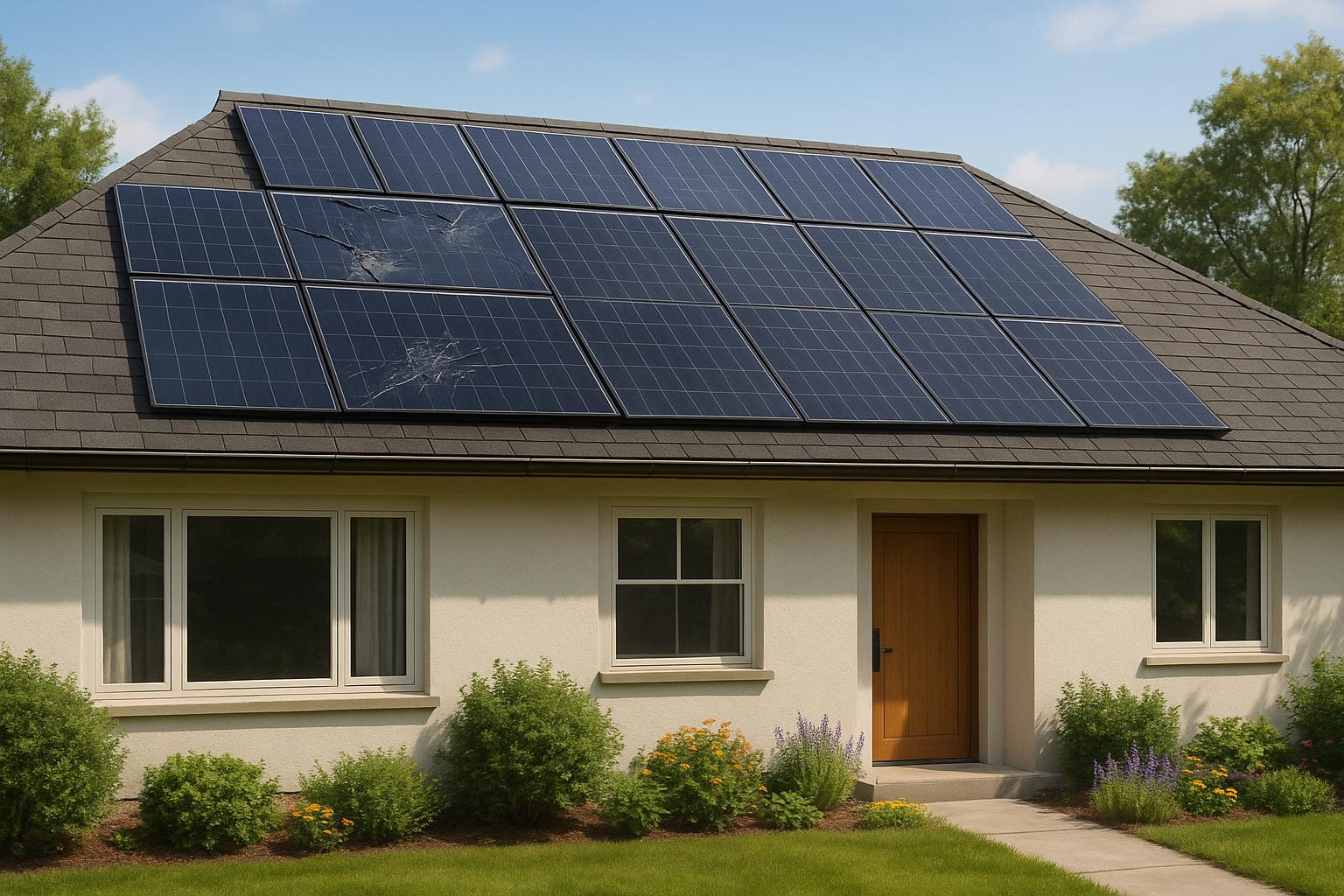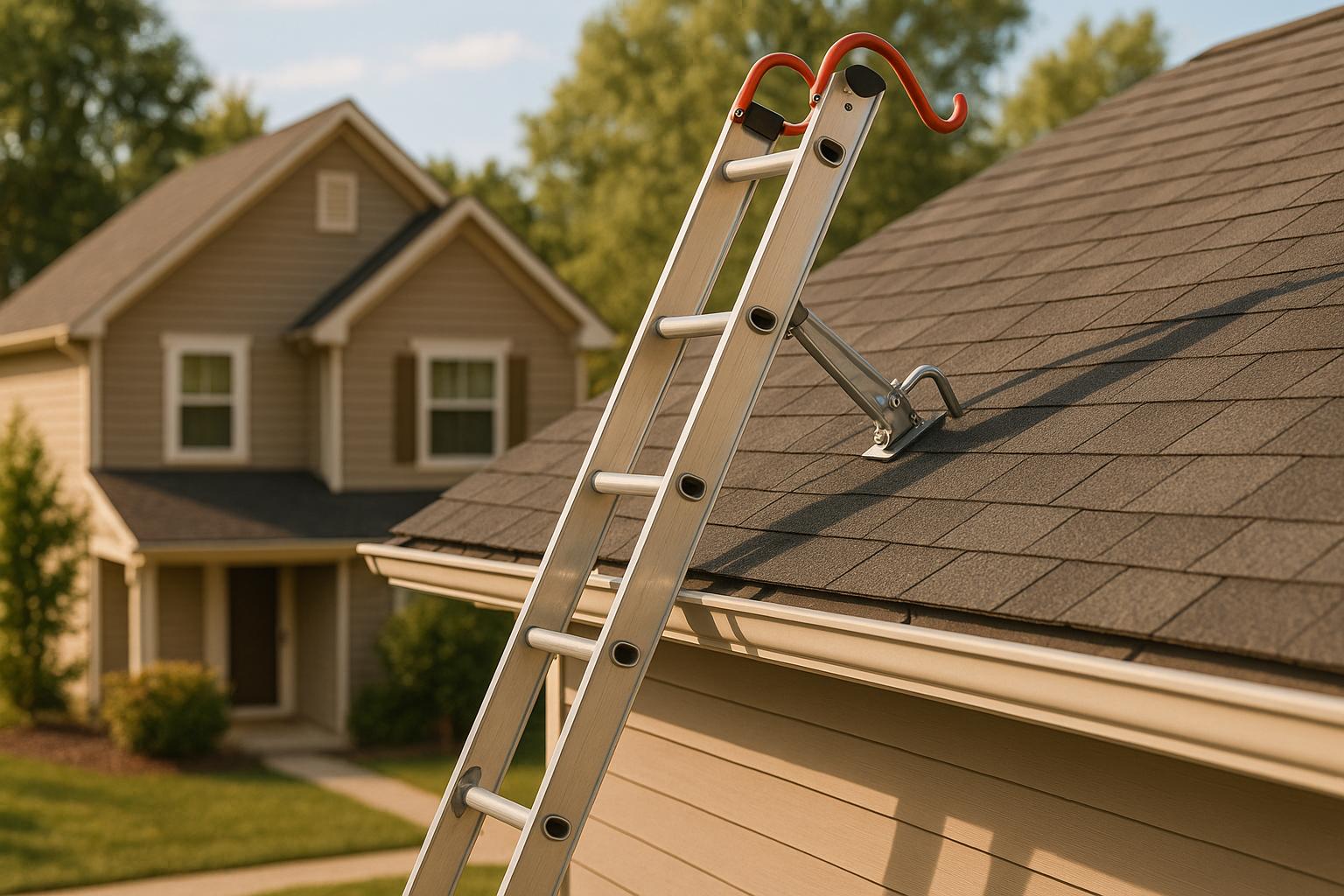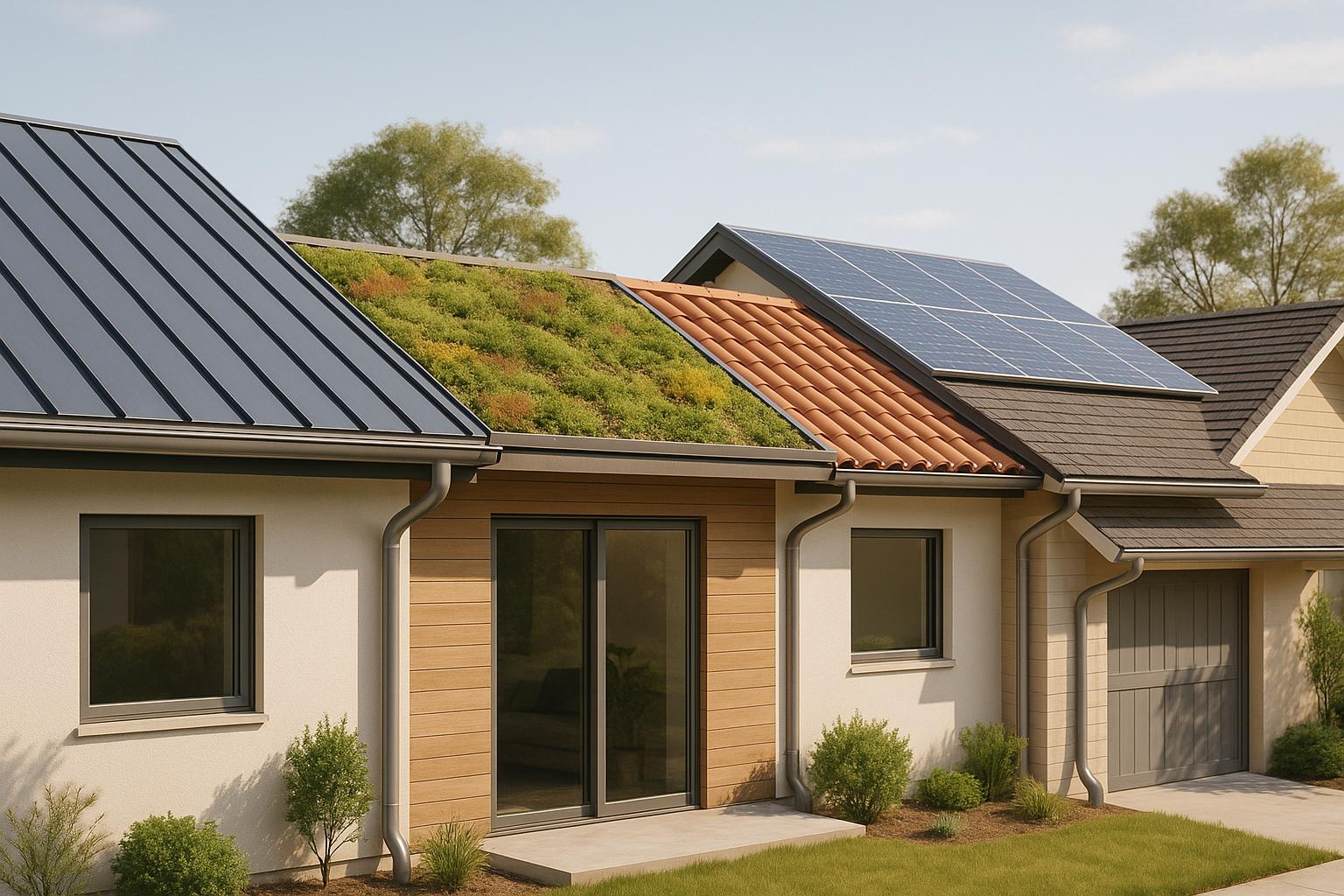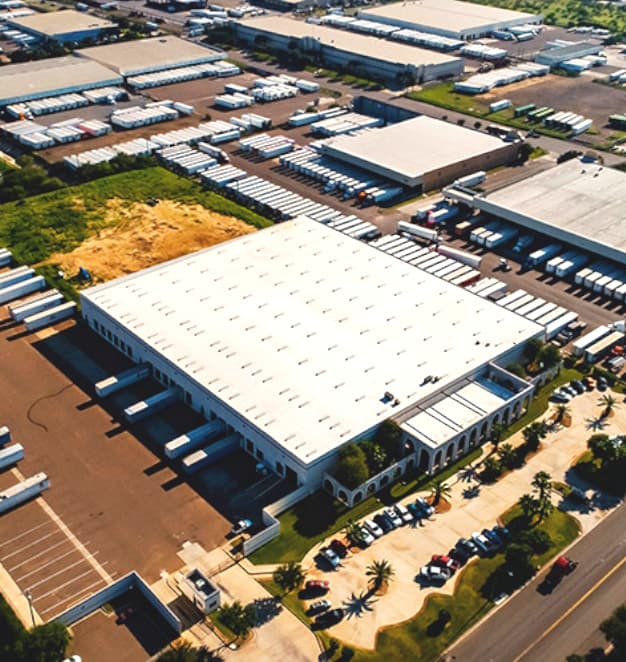Seamless gutters are custom-made, continuous systems that reduce leaks and require less maintenance compared to sectional gutters. These systems are ideal for managing Southern California’s intense but infrequent rainstorms, protecting your home’s foundation, walls, and landscaping. Here’s a quick overview of the process:
- Preparation: Inspect your roofline and fascia boards for damage, choose materials like aluminum or copper based on durability and cost, and design a layout with proper slopes and downspout placement.
- Fabrication: Gutters are crafted on-site using specialized machines for a precise fit.
- Installation: Securely attach gutters to the fascia, ensuring proper alignment, and install downspouts to direct water away from the foundation.
- Maintenance: Clean gutters twice a year and inspect for wear to ensure long-term performance.
Seamless gutters are a reliable choice for homeowners, combining durability, style, and functionality to prevent costly water damage. For professional installation in Los Angeles, consider reaching out to local experts.
How to Install a Seamless Gutter
Preparation and Planning
Taking the time to carefully prepare and plan your gutter installation can save you from costly mistakes and ensure your system works efficiently for years. By inspecting your property, choosing the right materials, and designing an effective layout, you’ll set the stage for a durable and functional gutter system.
Initial Roofline Inspection
Start by thoroughly inspecting your roofline to identify any issues that might compromise the gutter system. Pay close attention to the fascia boards and soffits. Fascia boards, which serve as the mounting point for gutters, should be free of cracks, rot, or peeling paint. Similarly, soffits, which allow air to circulate through the attic, must be in good condition to prevent heat and moisture buildup. Blocked soffits can lead to structural problems, so check for insulation or debris that might be obstructing airflow.
Look for signs of moisture issues, such as water stains or active leaks, which could signal existing drainage problems. Also, inspect for pests or damage that might interfere with the installation process. If you already have gutters, examine them for leaks, rust, clogs, or sagging to pinpoint issues your new system will need to address.
Create a checklist of necessary repairs and address them before installation begins. Tackling these problems early ensures a solid foundation for your new seamless gutters, setting them up for long-term success. Once the roofline is ready, you can shift your focus to selecting materials and styles that suit your home.
Choosing Materials and Styles
When selecting materials for your seamless gutters, it’s essential to balance durability, cost, and appearance. Aluminum gutters, the most popular option, cost between $13 and $35 per linear foot and require minimal maintenance. Steel gutters, priced at $17–$37 per linear foot, offer added strength, making them ideal for areas with heavy snow. For a premium option, copper gutters cost $30–$52 per linear foot and develop a distinctive patina over time. Zinc gutters, at $36–$62 per linear foot, are known for their longevity.
When it comes to style, K-style gutters are a great choice for areas with heavy rainfall, as they can handle more water than other designs. Meanwhile, half-round gutters have a smooth interior that reduces clogging and are often preferred for historical or traditional homes.
"Seamless gutters are an excellent addition to any home, providing both functional and aesthetic appeal. They have no joints or seams, which makes them less susceptible to leaks compared to their seamed counterparts." – Dan Ableson, Roofer in Raleigh, NC
For color, you can match your gutters to your roof for a subtle look or coordinate them with your siding or trim to highlight architectural features.
| Gutter Material | Cost per Linear Foot | Cost for 200 Linear Feet |
|---|---|---|
| Vinyl | $12–$34 | $2,400–$6,800 |
| Aluminum | $13–$35 | $2,600–$7,000 |
| Steel | $17–$37 | $3,400–$7,400 |
| Copper | $30–$52 | $6,000–$10,400 |
| Zinc | $36–$62 | $7,200–$12,400 |
Once you’ve chosen your materials and style, it’s time to design a layout that ensures efficient water drainage.
Designing the Layout
A well-thought-out gutter layout is key to effective water management and maintaining your home’s curb appeal. Start by calculating the slope: gutters should have a slight pitch of 1/4 inch for every 10 feet to ensure water flows smoothly toward the downspouts. This prevents standing water while avoiding an overly steep angle that could cause water to overshoot during heavy rains.
Place downspouts no more than 30 to 40 feet apart to ensure efficient drainage. Consider your landscaping, walkways, and overall property drainage when deciding where to direct water to protect your foundation.
Before installation, gather all necessary tools and materials. You’ll need safety gear like gloves, safety glasses, and hearing protection, along with tools such as a tape measure, chalk line, level, hacksaw, and power drill. Other essentials include gutter sections, connectors, end caps, downspouts, hangers, and seam sealant.
Make a checklist of all parts and accessories, and include a 10% overage to account for unexpected issues. If your home is surrounded by trees, consider adding leaf screens to keep debris out of your gutters. Finally, ensure all surfaces are primed and painted with exterior paint before installation to protect the materials and give your system a polished, professional appearance.
Fabrication and Installation
With all the prep work done, it’s time to fabricate and install your seamless gutters. This step is crucial for ensuring they perform reliably for years to come.
On-Site Gutter Fabrication
The beauty of seamless gutters lies in their custom, on-site fabrication. By forming continuous sections directly at the job site, you eliminate seams that could become weak points over time. Seamless gutter machines make this possible, using coil stock materials like aluminum, steel, or copper to create gutters tailored to your project.
Start by setting up your roll-forming gutter machine on a flat, stable surface. Modern machines are incredibly efficient, capable of producing up to 50 feet of gutter per minute with an impressive length accuracy of ±1/8 inch per 100 feet. The process involves selecting the right metal coil, loading it into the machine, and letting the rollers and bending mechanisms shape the material into your chosen gutter profile.
Here’s what you’ll need to get started:
- A gutter machine
- Coil cradles or spools for holding the raw material
- A guillotine cutter for clean, precise cuts
- Run-out stands to support the gutter as it exits the machine [30, 31]
Safety is key. Operators should wear safety glasses, gloves, and closed-toe shoes. Before starting, double-check that the workspace is clear and all power connections are secure. When loading the coil, align it properly with the cradles or spools and trim 3-inch "ears" on each corner of the lead edge. This small step prevents the coil from jamming. Using run-out stands or supports ensures that the gutters maintain their shape as they come out of the machine.
"Gutter machines are excellent investments for general contractors, roofing specialists, and companies in various other trades."
James T., the owner of Premier Commercial Gutters, shared his experience:
"The 6-inch Ironman gutter machine has transformed our commercial business. We can now handle large commercial projects with ease, and the quality of the gutters is exceptional. The machine paid for itself within the first year."
Once your custom sections are ready, it’s time to attach them securely to your home.
Installing the Gutters
With your seamless gutters fabricated, you can move on to installation. Start by inspecting the fascia board one more time to check for any damage or rot you might have missed earlier. Drill holes for the downspouts and attach downspout adapters, sealing these connections with waterproof sealant to prevent leaks.
Next, attach end caps to the gutter sections and install hidden hangers every 16 to 20 inches along the fascia. These hangers ensure a snug, secure fit. Maintain a slope of about 1/2 inch per 10 feet to guide water efficiently toward the downspouts. Position the gutter sections under the drip edge and fasten them with hanger screws, making sure the slope stays consistent.
Seal all joints and connections with a high-quality exterior sealant. This step is critical for keeping your gutters watertight. As one expert noted:
"Seamless gutters last longer, don’t require as much maintenance, and are less prone to clogs and leaks." – Angi
Adding Downspouts and Sealing Connections
The final step is installing the downspouts and sealing everything up. Start by attaching the first elbow to the downspout adapter, ensuring the crimped side faces downward for proper water flow. Measure, cut, and crimp the downspout pieces to fit securely with the elbows. Attach the downspout sections from the gutter to the ground, securing them with bands spaced every 6 to 8 feet for stability.
Make sure the bottom of each downspout directs water away from your home’s foundation. To do this, you can add splash blocks or extend the downspouts with extra piping, ensuring water is discharged at least 3 to 4 feet away. For added protection, consider installing gutter guards. These can be placed on top of the gutters and secured with screws, helping to keep debris out.
Finally, apply a high-quality exterior sealant to any remaining joints or connections. Allow the sealant to cure fully before exposing the system to water.
In regions like Southern California, where heavy rain can follow long dry spells, this thorough installation ensures your gutters can handle sudden surges in water flow, keeping your home’s foundation safe and sound.
sbb-itb-d1d6490
Final Inspection and Maintenance
After installation, a thorough review ensures your seamless gutters are ready to perform as intended. This step is especially crucial in Southern California, where heavy rains often follow extended dry periods. Verifying proper functionality and setting up a regular maintenance routine will help protect your home and keep the system working efficiently for years to come.
Testing the System
Once the gutters are installed, it’s time to put them to the test. Pour water at the highest points of the system to simulate rainfall and observe how it flows through the gutters and downspouts. This simple yet effective test can reveal any leaks, cracks, or pooling that might indicate alignment problems. Watch the water as it exits through the downspouts, ensuring it flows smoothly and away from your foundation. If you notice sluggish drainage or water backing up, there may be a blockage that needs clearing. Identifying and addressing these issues during the testing phase can prevent costly water damage later on.
Post-Installation Cleanup
Cleaning up the work area is an important final step. Remove all leftover materials, such as metal shavings, old gutter pieces, and packaging debris. Rinse the gutters with clean water to wash away any dust or particles left from the installation process. Double-check that all components, including downspouts and hangers, are securely in place. Ensuring the area is tidy and free of obstructions will leave your home looking polished and ready for the next rainstorm.
Routine Maintenance Tips
Keeping your gutters in top shape requires regular upkeep. In Southern California, where dry seasons are followed by intense rains, cleaning your gutters at least twice a year – typically in the spring and fall – is essential. Use your hands or a scoop to remove large debris, then flush the system with a garden hose to clear out smaller particles.
While cleaning, inspect your gutters and downspouts for signs of wear, such as rust on steel gutters or chalky deposits on aluminum, which may indicate corrosion. Check for alignment issues to ensure the gutters remain securely attached to the fascia board. To minimize clogs, consider installing gutter guards or screens, and trim any overhanging branches that could drop debris into the system.
Additionally, periodically check the slope and alignment of your gutters. Over time, factors like thermal expansion, settling, or heavy debris can cause shifts. Adjust hangers or brackets as needed to maintain proper drainage. Confirm that downspouts remain clear and direct water away from your home’s foundation.
Seamless gutters offer significant advantages, cutting maintenance time by up to 50% compared to traditional systems and reducing leaks by as much as 90%. However, neglecting maintenance can lead to serious issues – approximately 80% of home water damage stems from poorly maintained gutters. By staying on top of routine care, you protect both your home and the longevity of your gutter system.
For professional seamless gutter installation and maintenance in Southern California, reach out to Prime American Roofing (https://primeamericanroofing.com) to keep your system in peak condition.
Benefits of Seamless Gutter Systems
When installed correctly, seamless gutters bring durability, style, and minimal upkeep to homes in Los Angeles. These features make them a standout choice compared to sectional systems, perfectly complementing the installation process outlined earlier.
Durability and Longevity
What makes seamless gutters different? It’s the lack of seams and joints. These are the weak spots in traditional sectional systems where problems often start. Without those vulnerable points, seamless gutters are better equipped to handle harsh weather conditions. Plus, since they’re custom-made to fit each home, they provide a snug fit that enhances durability. Depending on the material, their lifespan is impressive – aluminum can last 20–30 years, steel 30–50 years, and copper an incredible 50–150 years.
Better Appearance
Seamless gutters don’t just work well – they look great too. Their continuous design offers a sleek, polished look that complements almost any architectural style in Los Angeles. Homeowners can customize their gutters to match their home’s color scheme and design, ensuring a cohesive and attractive exterior. With a variety of styles and colors available, it’s easy to find an option that fits perfectly.
This improved curb appeal isn’t just about looks. Homes with seamless gutters often see an increase in property value. Potential buyers are drawn to homes that promise durability and require less immediate maintenance, and many are willing to pay more for these features.
Lower Maintenance Requirements
Seamless gutters go beyond aesthetics – they’re also practical. Their smooth interior surfaces and lack of seams mean less debris buildup and fewer clogs. This design also minimizes the risk of leaks, sparing homeowners from costly water damage repairs. Unlike sectional systems, which can struggle to maintain water flow due to clogs at the joints, seamless gutters keep everything running smoothly.
With regular care, seamless gutters can last two decades or more, and some materials can extend well beyond that. Their durability and reduced maintenance needs make them a smart investment for Los Angeles homeowners, especially given the region’s weather patterns of long dry spells followed by heavy rains.
Conclusion
Seamless gutters provide a durable and efficient solution for protecting your Southern California home while also enhancing its value. The process, from the initial roofline inspection to the final testing, ensures a custom-fit system that surpasses traditional sectional gutters in performance. By reducing the potential for leaks by 80–90%, requiring only 1–2 cleanings per year instead of 3–4, and increasing home value by $1,000–$3,000, seamless gutters offer a practical and long-lasting option that can perform reliably for 25–40 years.
"Many homeowners we work with love the seamless gutters and choose them over sectional gutters because they act like accent trim around your home, rather than looking like an eyesore. Not only that, they require much less maintenance and have fewer issues than sectional gutters."
- Jose Figueroa, Angi Expert Review Board member
Professional installation, costing around $6–$15 per linear foot, ensures that your gutters are fabricated on-site for a precise fit. This custom design effectively channels rainwater away from your foundation, reducing the risk of costly water damage to basements, landscaping, and structural elements.
For Southern California homeowners and businesses, Prime American Roofing offers specialized seamless gutter installation services across the Los Angeles area. Using high-quality materials and precise installation techniques, they deliver gutter systems designed to perform dependably for years, providing peace of mind through all weather conditions.
With their durability, sleek appearance, and reduced maintenance needs, seamless gutters are an excellent choice for long-term property protection. Reach out to Prime American Roofing to explore a custom seamless gutter solution tailored to Southern California’s unique climate.
FAQs
What makes seamless gutters better than traditional sectional gutters?
Seamless gutters offer several standout benefits compared to traditional sectional gutters. Designed to fit your home perfectly and built without joints or seams, they greatly minimize the chances of leaks and water damage. This makes them a dependable choice for safeguarding your foundation and landscaping from excess water.
Another advantage is that seamless gutters are much easier to maintain. With fewer places for debris to collect, clogs become less of a hassle. Plus, their seamless design enhances durability by reducing the risk of corrosion or wear over time. In short, seamless gutters are a long-lasting, low-maintenance way to handle rainwater efficiently.
What’s the best material and style for seamless gutters to suit my home and local weather conditions?
Choosing the right material and style for seamless gutters comes down to your home’s specific needs and the local climate. Aluminum gutters are a top pick nationwide because they’re lightweight, resist rust, and hold up well in areas with heavy rain or freezing temperatures. In regions that experience frequent, intense rainfall, steel gutters provide the extra strength needed to handle large volumes of water. If you’re after a high-end, timeless option, copper or zinc gutters deliver durability and a classic appearance, though they come with a higher price tag.
The style of gutters is just as important as the material. K-style gutters are a practical choice for managing larger amounts of water, making them a common option for many homes. On the other hand, half-round gutters offer a more traditional look, fitting well with older or historically styled homes. Choosing a material and design that matches your home’s architecture and can handle your area’s weather will ensure your gutters perform well for years to come.
How can I maintain my seamless gutters to ensure they last and work efficiently?
To keep your seamless gutters in good shape, make it a habit to clean them at least twice a year – ideally in the spring and fall. This routine helps clear out leaves, dirt, and other debris, preventing clogs that could lead to water damage around your home.
It’s also important to check your gutters regularly for any signs of wear and tear, like cracks, sagging sections, or leaks. Tackling these small issues early can save you from dealing with expensive repairs later. If you want to cut down on debris buildup and make upkeep easier, you might want to look into installing gutter guards.
For extra reassurance, consider having a professional inspect your gutters annually. They can ensure everything is working as it should and spot problems you might have overlooked. By keeping up with maintenance, you can help your gutters last longer and shield your home from water damage.

